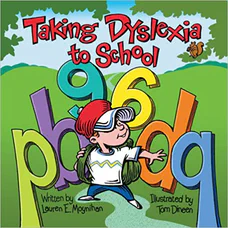Taking Dyslexia to School

Recommended Age Range: 1st grade through 3rd grade.
Publisher's Summary:
In Taking Dyslexia to School, a young boy with dyslexia shares how difficult school has been for him. With help from his teachers and parents, he learns new techniques for school success.

Dr. Annie's Takeaways
Recommended for: This book is best for children who have recently gone through neuropsychological or psychoeducational testing and have been given a diagnosis of dyslexia. It normalizes the testing process, briefly explains the diagnosis, and shares about different accommodations that have helped the narrator improve his reading and better access his education. If a child is expressing confusion, worry, or shame about their diagnosis or recommended accommodations, this book could be a start to reassuring and clarifying conversations with a trusted adult.
Evidence-Based Practices:
Psychoeducation
Tone: Matter-of-fact, informative, upbeat
Story Quality: This is an informational text about dyslexia written from the perspective of a kid with dyslexia, which makes it a tiny bit fun. It isn’t particularly engaging as a story, but it’s written clearly and does a nice job explaining the process of getting a dyslexia diagnosis and what happens after.
Illustrations: The illustrations are cartoony digital graphics in bold colors.
Representation: Matt is a White boy “with dyslexia.” He shares that he has trouble with reading and sometimes math. He has a White mother. Matt meets with Ms. Jackson, who facilitates testing and diagnoses Matt with dyslexia. Ms. Jackson is a Black woman. Matt has a special education teacher, Mr. Davis, who helps him learn “all kinds of tricks” to make reading easier. Mr. Davis is a Black man. The book names Albert Einstein, Thomas Edison, and Michelangelo as role models with dyslexia. These are all White men.
Psychological Practices: This book defines dyslexia as a “a kind of learning disability, which is a grown-up way of saying that sometimes it’s hard for me to learn…I have trouble with reading and sometimes math… Having dyslexia doesn’t mean I can’t learn. My teacher says I’m very smart.” Matt shares about his experience doing psychoeducational testing–“This test wasn’t like other tests I took at school”– and getting diagnosed with dyslexia. He describes the plan to help him learn more effectively (e.g., sessions with a reading specialist at school, getting extra time on tests, having tests read out loud, reading every night with his mom), and he is enthusiastic about the outcome. The book ends with Matt sharing about his friend’s dad who is a lawyer with dyslexia, and he concludes, “I know I can be anything I want to be when I grow up.”
Concerns: The book has a few outdated references in it (it was published in 2002) and it generally feels a bit dated. There are references to TV channels being fuzzy, and Matt shares that he enjoys listening to books on tape. There is also a line about kids giggling when Matt reads aloud in class. If a child has unfortunately experienced this, Matt’s experience could make them feel less alone. If they haven’t, this line is unnecessarily stigmatizing.
